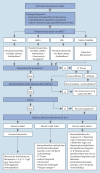[Management of infections in patients with cancer]
- PMID: 35310897
- PMCID: PMC8922085
- DOI: 10.1007/s00761-022-01120-z
[Management of infections in patients with cancer]
Abstract
Patients with cancer are at increased risk of infection due to disease-associated or therapy-induced immunosuppression. Taking into account globally increasing antimicrobial resistance rates and negative effects associated with antibiotic treatments, the effective, appropriate and guideline-conform use of anti-infectives must be promoted in this clinical setting. The application of antibacterial prophylaxis should be limited to high-risk patients. Infection diagnostics and therapeutic strategies differ depending on the extent of expected immunosuppression and the patient's individual risk factors.
Hämatologische und onkologische Patienten haben aufgrund der durch die Grunderkrankung bestehenden oder therapieassoziierten Immunsuppression oftmals ein deutlich erhöhtes Infektionsrisiko. Unter Berücksichtigung weltweit zunehmender antimikrobieller Resistenzen und negativer mit der Antibiotikatherapie assoziierter Effekte sollte der angemessene und leitliniengerechte Einsatz von Antiinfektiva auch in diesem Bereich gefördert werden. Die Indikation zur antibakteriellen Prophylaxe sollte streng gestellt werden. Die Infektionsdiagnostik sowie das therapeutische Management unterscheiden sich je nach Ausmaß der erwarteten Immunsuppression und nach vorliegenden patientenindividuellen Risikofaktoren.
Keywords: Antibiotic prophylaxis; Antibiotic stewardship; Drug resistance, microbial; Immunosuppression; Infections/risk factors.
© The Author(s), under exclusive licence to Springer Medizin Verlag GmbH, ein Teil von Springer Nature 2022.
Similar articles
-
[Organisational and staff requirements for antimicrobial stewardship activities in hospitals : Position paper of the Commission on Anti-Infectives, Resistance and Therapy (Commission ART) at the Robert Koch Institute, with advice from professional associations].Bundesgesundheitsblatt Gesundheitsforschung Gesundheitsschutz. 2020 Jun;63(6):749-760. doi: 10.1007/s00103-020-03152-5. Bundesgesundheitsblatt Gesundheitsforschung Gesundheitsschutz. 2020. PMID: 32468301 Review. German.
-
Impact of antimicrobial stewardship managed by clinical pharmacists on antibiotic use and drug resistance in a Chinese hospital, 2010-2016: a retrospective observational study.BMJ Open. 2019 Aug 2;9(8):e026072. doi: 10.1136/bmjopen-2018-026072. BMJ Open. 2019. PMID: 31377693 Free PMC article.
-
Integrating rapid diagnostics and antimicrobial stewardship improves outcomes in patients with antibiotic-resistant Gram-negative bacteremia.J Infect. 2014 Sep;69(3):216-25. doi: 10.1016/j.jinf.2014.05.005. Epub 2014 May 17. J Infect. 2014. PMID: 24841135
-
Indications for medical antibiotic prophylaxis and potential targets for antimicrobial stewardship intervention: a narrative review.Clin Microbiol Infect. 2022 Mar;28(3):362-370. doi: 10.1016/j.cmi.2021.10.001. Epub 2021 Oct 12. Clin Microbiol Infect. 2022. PMID: 34653572 Review.
-
Adherence to European Association of Urology Guidelines on Prophylactic Antibiotics: An Important Step in Antimicrobial Stewardship.Eur Urol. 2016 Feb;69(2):276-83. doi: 10.1016/j.eururo.2015.05.010. Epub 2015 May 20. Eur Urol. 2016. PMID: 26001610
References
-
- Molina J, Noguer M, Lepe JA, et al. Clinical impact of an educational antimicrobial stewardship program associated with infectious diseases consultation targeting patients with cancer: Results of a 9-year quasi-experimental study with an interrupted time-series analysis. J Infect. 2019;79(3):206–211. doi: 10.1016/j.jinf.2019.07.002. - DOI - PubMed
-
- Baur D, Gladstone BP, Burkert F, et al. Effect of antibiotic stewardship on the incidence of infection and colonisation with antibiotic-resistant bacteria and Clostridium difficile infection: a systematic review and meta-analysis. Lancet Infect Dis. 2017 doi: 10.1016/S1473-3099(17)30325-0. - DOI - PubMed
Publication types
LinkOut - more resources
Full Text Sources

